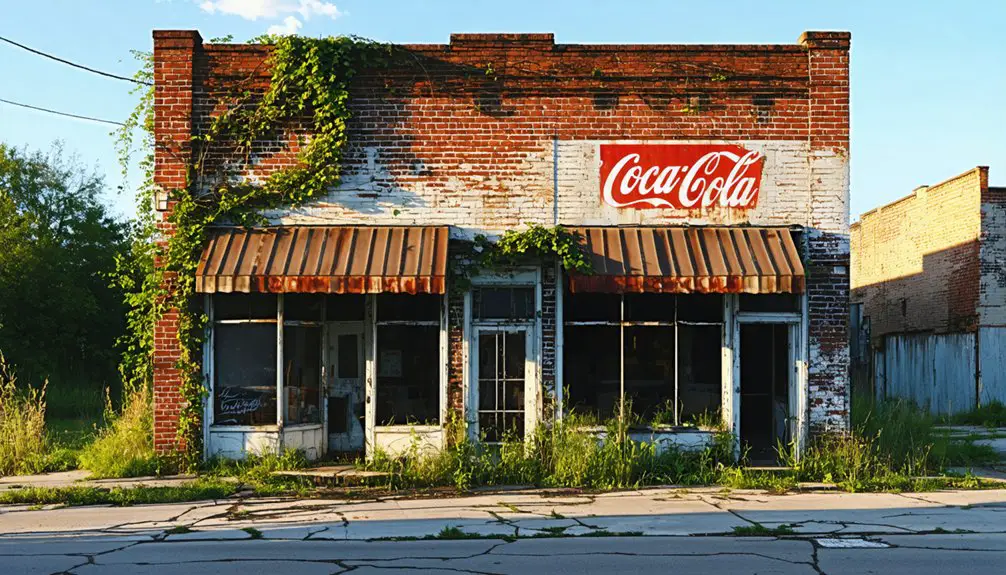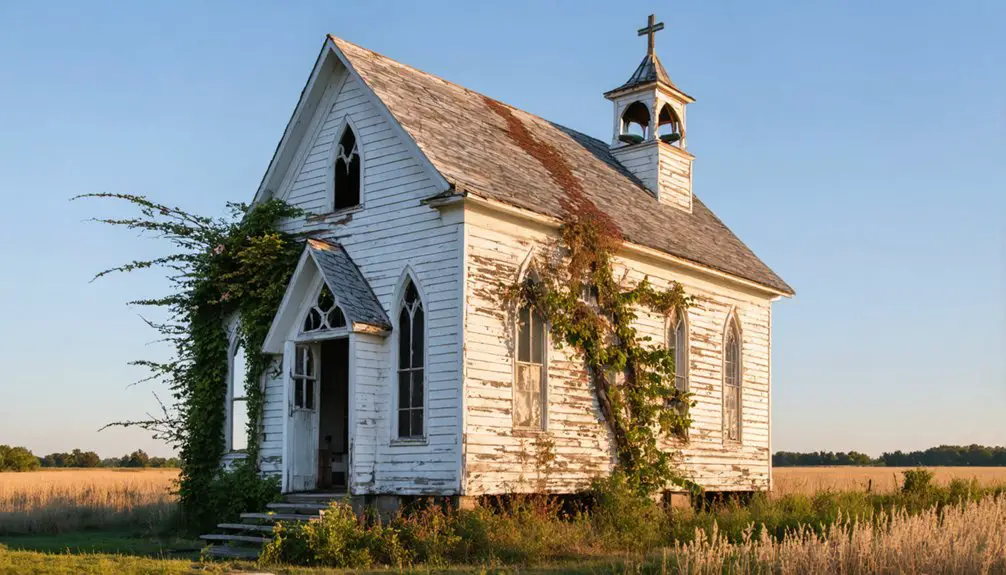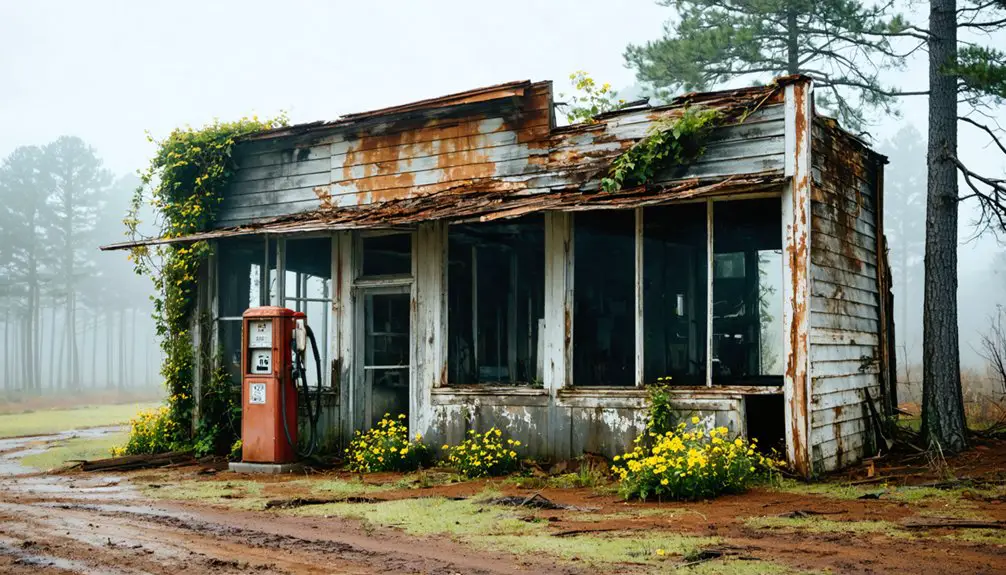You’ll find the lost river port of Prentiss, Mississippi beneath the Mississippi River’s waters today. During the 1860s, this thriving settlement boasted 800 residents, complete with hotels, saloons, and a bustling cotton trade. Union forces under Sherman burned the town in 1863, and though residents attempted rebuilding, the river’s erosion gradually consumed it. A brief 1954 sighting of its brick courthouse reminded the world of Prentiss’s remarkable story.
Key Takeaways
- Prentiss was a thriving Mississippi River town with 800 residents by 1860, featuring hotels, saloons, and a vital ferry crossing.
- Union forces under William Tecumseh Sherman destroyed the town during the Civil War in 1863, burning everything except one building.
- The Mississippi River’s erosion gradually consumed the town, with major floods in 1927, 1973, and 1983 accelerating its destruction.
- Archaeological discoveries in 1954 revealed remnants including a brick courthouse, champagne bottles, and whiskey barrels beneath the river.
- The town now lies completely submerged beneath the Mississippi River, serving as a testament to nature’s power over human settlements.
A Bustling River Port’s Rise to Power
Three key factors propelled Prentiss’s rise to prominence as an essential Mississippi River port in the mid-19th century. First, you’d find the only ferry crossing between Vicksburg and Memphis there, making it a vital transportation hub for both people and goods.
Prentiss emerged as a crucial river crossing, uniquely positioned as the sole ferry point between two major Mississippi ports.
Second, its strategic location near Beulah Bend created a natural checkpoint for river commerce, drawing steamers, flatboats, and freight vessels to its bustling landing. The town’s careful attention to name disambiguation helped distinguish it from other Prentiss locations across America.
As river traffic flourished, population growth followed, reaching 800 residents by 1860. You’d have seen a thriving town complete with a hotel, newspaper office, and racetrack. The town’s gambling houses and lively saloons contributed to its reputation as an entertainment destination.
The port’s significance extended beyond local trade – it served as the lifeline for surrounding plantations, connecting their cotton exports to broader markets while fostering a vibrant social and commercial atmosphere along the Mississippi’s banks.
Civil War’s Devastating Blow
As Confederate forces exploited Beulah Bend’s sharp river curve to ambush Union vessels, they inadvertently sealed Prentiss’s fate in 1863.
You’ll find that these guerrilla attacks from the wooded areas near Beulah Bend proved devastating to Union shipping, prompting a fierce military strategy under William Tecumseh Sherman’s command.
The civilian suffering that followed was unprecedented. Sherman’s gunships burned Prentiss to the ground, sparing just one small building on the outskirts. Similar to Colonel David Moore’s patrol, these early warning signs of Confederate activity were often overlooked by Union leadership.
This punitive action aimed to deny Confederate forces a base of operations, but it devastated local families who lost their homes and livelihoods.
While the town’s residents showed remarkable resilience by beginning immediate rebuilding efforts, their struggles weren’t over.
Union Commander Selfridge’s solution – cutting the Napoleon Channel – would ultimately lead to Prentiss’s complete submersion.
The River’s Slow Conquest
While Sherman’s destruction marked Prentiss’s initial downfall, the Mississippi River’s relentless force would ultimately seal the town’s fate. You can trace the river’s slow conquest through decades of ruthless erosion processes, as the mighty Mississippi gradually devoured what remained of the settlement.
The river dynamics proved unstoppable. Major floods in 1927, 1973, and 1983 accelerated the town’s demise, with high waters lasting weeks and undermining the saturated riverbank. The Great Flood of 1927 was particularly devastating, causing an estimated $1 billion in damages across seven states. These destructive floods typically occurred during growing seasons, severely impacting agricultural activities in the region.
By the 1870s, the Mississippi had physically swallowed the original town site. A brief glimpse of Prentiss’s remnants emerged in 1954 when the river’s course shifted, exposing the old brick courthouse.
But like everything else in this ghost town’s story, even these fragments soon vanished beneath the river’s muddy waters.
Glimpses From the Deep: the 1954 Discovery
Once hunters spotted a brick chimney jutting from the Mississippi’s muddy riverbed in 1954, word spread quickly about Prentiss’s unexpected reemergence.
The temporary exposure of this long-submerged ghost town drew nationwide attention as explorers and historians rushed to examine the ruins. You’d have seen the brick courthouse standing defiantly against time, while amateur archaeologists sifted through river mud uncovering archaeological treasures. The region’s history was carefully documented in cemetery records dating back to 1958.
Among the discoveries, you’d have found champagne bottles and whiskey barrels that told stories of the town’s vibrant past. The area would later become home to the historic Rosenwald Building in 1926.
This rare glimpse into Prentiss’s underwater world lasted only until the river reclaimed its territory, but the artifacts recovered during this brief window provided invaluable insights into life along the Mississippi during the mid-1800s.
Legacy of a Lost Mississippi Settlement
The story of Prentiss stands as a haunting evidence to how war and nature can erase an entire settlement from the map.
You’ll find its historical significance woven into the fabric of Civil War strategy and river commerce, where it once served as the sole ferry crossing between Vicksburg and Memphis.
While the town’s physical remains lie beneath the Mississippi’s waters, its legacy lives on through archaeological findings and local memory.
- The Napoleon Channel’s construction forever altered the river’s course, showing how military decisions can reshape landscapes.
- The 1954 drought revealed whiskey barrels and champagne bottles, offering a glimpse into the town’s prosperous past.
- Prentiss’s submersion serves as a stark reminder of how quickly thriving communities can vanish, leaving only stories behind.
Frequently Asked Questions
Are There Any Descendants of Original Prentiss Residents Still Living Today?
You’ll find it’s hard to confirm living descendants with certainty, though local Prentiss family descendant stories suggest some residents likely have ancestral ties to the original pre-Civil War settlement.
What Was the Total Financial Loss When Prentiss Was Submerged?
Ever wonder about the true cost of a lost town? You won’t find documented figures for the financial impact, though the historical significance includes loss of infrastructure, businesses, and properties from the 1870s submersion.
Were Any Important Historical Documents Saved Before the Town’s Destruction?
You won’t find any confirmed cases of historical preservation or document recovery from this period. All evidence suggests the town’s records were lost between Sherman’s destructive march and the river’s eventual submersion.
How Deep Underwater Are the Remains of Prentiss Currently Located?
Hidden beneath time and tide, you’ll find ghostly legends at approximately 100 feet deep, though underwater archaeology is challenging due to river sediment constantly shifting and obscuring these mysterious remains.
Did Any Other Mississippi River Towns Suffer a Similar Fate?
You’ll find many river town histories mirror this pattern – Rodney, Grand Gulf, Napoleon, and Plymouth were all abandoned settlements that declined when the Mississippi River changed course or flooding intensified.
References
- https://www.onlyinyourstate.com/state-pride/mississippi/underwater-ghost-town-hiding-in-ms
- https://en.wikipedia.org/wiki/Prentiss
- https://www.lostcolleges.com/prentiss-institute
- https://kids.kiddle.co/Prentiss
- http://freepages.rootsweb.com/~gtusa/history/usa/ms.htm
- https://msgw.org/prentiss/Carrolcom.html
- http://msgw.org/bolivar/HBCCitiesTownsVillages.pdf
- https://apps.dtic.mil/sti/tr/pdf/ADA627341.pdf
- https://emergingcivilwar.com/2023/04/06/everett-peabody-on-the-threshold-of-shiloh/
- https://www.battlefields.org/learn/civil-war/battles/brices-cross-roads



